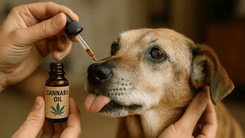How to Use Cannabis on Your Pet: 5 Essential Tips Before Starting Treatment
Discover 5 essential tips for using cannabis on your pet safely and effectively, with guidance from integrative veterinarian Viktória Wensko Imparato
Published on 09/26/2025

Essential care for pet owners who want to use cannabis on their pet | Reproduction IA
Taking care of a pet goes far beyond feeding and walking. When it comes to using cannabis on your pet, care needs to be even more meticulous. Integrative veterinarian Viktória Wensko Imparato shares fundamental tips for pet owners who want to start this type of treatment, ensuring safety and effectiveness.
Cannabis on your pet: essential tips
1. Seek a qualified professional
According to Dr. Viktória, the first step to using cannabis on your pet is to find a veterinarian who truly understands the endocannabinoid system and the different cannabis formulas.
“The first thing to do is to look for a professional who is competent to choose the best oil, according to the concentration and proportion of cannabinoids, whether it will be full spectrum or not for the animal,” she explains.
Correct guidance is essential for the treatment of using cannabis on your pet to be safe and effective.
2. Perform a complete check-up
Before using cannabis on your pet and starting therapy, detailed exams help prevent complications, especially in older pets.
“I always make sure that the animal has had at least a complete check-up: abdominal ultrasound, kidney function, liver function, blood count, electrocardiogram. This ensures that there will be no problems during treatment,” advises the veterinarian.
3. Avoid common administration mistakes
One of the biggest mistakes pet owners make is administering the medication directly into the pet's mouth or not informing the veterinarian about the perceived effects.
“People are usually used to homeopathy droppers and forget that oils have different doses. Another common mistake is not reporting to the veterinarian what is happening with the animal. Communication is key,” warns Viktória.
Read Also:
From pain to relief: how cannabis supports pets and horses
Over 7 thousand pets treated with cannabis in 2025, survey shows
4. Monitor treatment progress
Recording the pet's symptoms and behavior changes is essential to adjust the treatment. “I like to ask pet owners to use a symptom scale. For example: pain before treatment rated 8, after a few days rated 4. This helps both the owner and the veterinarian to see the results,” she explains.
5. Understand the benefits and practical cases
Dr. Viktória shares success stories that demonstrate the success of using cannabis on your pet and how it can improve the quality of life of four-legged friends.

“My Golden Chanel, at 14 years old, started feeling a lot of pain and difficulty moving. On the first day with Full Spectrum oil, she got up and chased the ball. And my cat, who suffered from inflammatory bowel disease, had the vomiting episodes drastically reduced,” she says.
She also recalls that skin and itching cases can benefit from treatment, like the example of pitbull Melancia, rescued and now healthy and active thanks to cannabis therapy.








